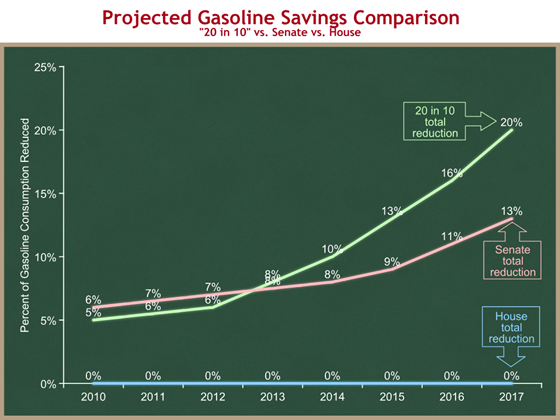In his State of the Union address, the President proposed an energy plan we call Twenty in Ten. The goal is to reduce U.S. gasoline usage by 20% within 10 years (by 2017). There are two main components to 20 in 10 that would reduce gasoline usage:
- fuel economy standards – we would increase the CAFE (Corporate Average Fuel Economy) standards, and modify the way we do CAFE; and
- we would increase and expand the Renewable Fuel Standard, to encourage (mandate) that more alternative fuels be used domestically.
We’ve got other important policy proposals having to do with fuel, including proposals to increase domestic production of oil and natural gas, to increase refinery capacity, and to double the size of the Strategic Petroleum Reserve. But today I want to focus on the two quantitatively important components of 20 in 10.
We can split our thinking about energy policy into two separate buckets: (1) fuel for transportation, and (2) power (electricity). In America, they’re largely separate. Oil powers 97% of our transportation, with the rest coming from renewable fuels like ethanol and biodiesel. Our power comes from coal (50%), natural gas (20%), nuclear (20%), hydroelectric (7%), wind (0.4%), and a few other smaller sources. Because battery technology isn’t yet advanced enough to make it practical to store electricity and use it for transportation, and because oil is expensive enough that we don’t use it for power, you can think of fuel and power as largely separable policy issues.
When you hear elected officials talk about energy security or energy independence, they’re almost always talking about fuel and not power. The short version is that (1) more fuel-efficient vehicles make our economy less vulnerable to a sudden spike in the price of oil/gasoline, and (2) the more ability drivers have to rapidly substitute other fuels for gasoline, the more flexibility we have, and our energy security is increased.
If the President’s 20 in 10 policy were enacted as he proposed it, the expanded Alternative Fuel Standard would reduce our gasoline usage by 15% in 2017. The proposed CAFE reform would save up to 5% more, for a total of 20%. Although you won’t read it much in the popular press, our proposal is more aggressive than any other major proposal out there.
The Senate passed an energy bill in June that contains these two components, but in different forms. While we have big problems with some of the ways these two policies are implemented in the Senate-passed bill, at least the bill tries to move in the right direction.
Later this week the House will take up two energy bills with much ado. To quote Speaker Pelosi’s website:
Energy independence is a national security issue, an economic issue, and an environmental issue. With gasoline prices at record levels, Americans are feeling the pain at the pump. They worry about the security of our nation and our growing dependence on foreign oil. Fortunately, the answer to this long-term challenge is right here at home.
The New Direction Congress has undertaken an ambitious legislative agenda to lead us on a path to energy independence, strengthen national security, grow our economy and create new jobs, lower energy prices, and begin to address global warming. During the week of July 30th, the House will consider the New Direction for Energy Independence, National Security, and Consumer Protection Act, H.R. 3220. This legislation invests in new energy technologies and innovation to create new jobs; improves energy efficiency for a wide range of products, lighting and buildings to reduce energy costs to consumers; makes the federal government a leader in reducing energy usage and greenhouse gas emissions; and strengthens research and diplomatic efforts on climate change to protect our planet.
You will notice that nowhere in this statement do you see anything about H.R. 3320 reducing gasoline usage. Unfortunately, differences among the House majority have meant that their bills do nothing to reduce our gasoline usage. Zippo.
On the following graph, higher is better: more gasoline savings means our economy is less vulnerable to oil and gasoline supply shocks.
As you can see:
- The President’s proposal would cut U.S. gasoline consumption by 20% within 10 years.
- The Senate-passed bill would cut U.S. gasoline consumption by 13% within 10 years.
- The House bills would do nothing to reduce our gasoline consumption.
So what is in the House bills?
- Repealing some tax credits for oil and gas drilling which were enacted in 2005.
- Raising other taxes on oil companies, in particular denying them foreign tax credits for the investments they make overseas.
- Some provisions to slow down domestic drilling for oil and natural gas.
- Some new appliance efficiency standards, lighting standards, and green building codes.
- Some minor incentives for alternative fuel vehicles, and some research dollars for biofuels (some of which is earmarked).
- Some small business incentives to purchase energy efficient buildings, fixtures, equipment, and technology.
We think almost all of the House bills’ provisions are unnecessary, duplicative, or a hindrance to existing authority, or they move energy policy in the wrong direction. We understand that others might disagree.
Two facts are, however, indisputable:
- This bill does nothing to reduce U.S. gasoline usage. It lacks the two most important components of a policy that one would need to actually increase America’s energy (fuel) security.
- The first two items listed above in the House bills would reduce incentives both for domestic production, and for foreign production by U.S. firms.
When you’re filling up your tank, remember:
- The President is trying to increase American energy security and has proposed policies to significantly reduce America’s gasoline usage.
- The Senate-passed bill goes partway toward the President’s goal (although it’s got some problems in the way they do it).
- The House bills about to be debated ignore the problem entirely.
